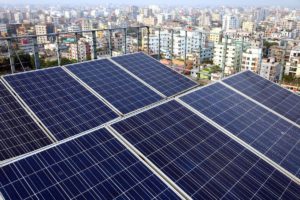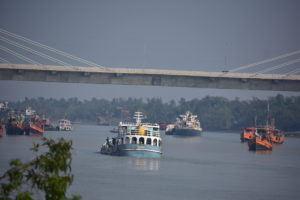Within the next three years, CAF – the development bank that brings together 18 Latin American and Caribbean countries, plus Portugal, Spain and 13 private banks – hopes to have transformed itself into the region’s “green bank”. To work towards this, it has set a target of 40% of its financing going towards green projects by 2026 – a figure that stood at 26% in 2021.
But it will not be a simple path, according to Alicia Montalvo, CAF’s manager for Climate Action and Positive Biodiversity. Environmental issues, she says, are not always among the region’s priorities, while its countries lack coordinated approaches in such areas, making it difficult to carry out regional projects to reduce emissions and protect biodiversity.
Montalvo spoke with Diálogo Chino at Innovate4Climate, the World Bank’s annual climate finance conference, describing the role of green finance for Latin America, and explaining CAF’s decision to continue investing in natural gas. She also made calls for nature to be valued economically in order to facilitate sustainable investments.
Diálogo Chino: What steps has CAF taken to focus its financing in Latin America on sustainable projects, and to become a green bank?
Alicia Montalvo: We are strengthening the mainstreaming of climate change and biodiversity in all our financing in the region, from infrastructure to energy to water resources. It is a green and blue agenda, as we have also committed US$1.25 billion towards coastal and marine ecosystems from 2022 to 2026. But it is not only about our financing: we also need the countries to put together good projects. This is not easy in a region that does not always have priorities linked to sustainability.
Although CAF has committed to increasing green financing, it still finances natural gas projects in Latin America. Why is it doing this?
The bank’s shareholders ask us to continue financing gas projects, understanding that these are part of the energy transition. We are looking for these projects to replace more polluting energies, and not to finance gas just for the sake of it. It is only “green” if it replaces another more polluting fuel. The transition must be fair, and allow each country to have its own emissions peak associated with fossil fuels, according to its technological capacity. Renewables are still not competitive enough in several Latin American countries, and the energy transition is going to take some time.
In your speech at the Innovate4Climate conference, you highlighted the importance of going “beyond carbon” and valuing ecosystems for all the services they provide. What relevance does this have for Latin American ecosystems such as the Amazon?
The Amazon provides multiple environmental services, but it is often valued only for its capacity to absorb emissions. Going “beyond carbon” means giving forests a value beyond that, especially considering their importance for people’s livelihoods. Many companies now seek to be carbon neutral, but should have similar objectives to reduce their impacts on biodiversity. There is an artificial separation between climate and biodiversity. In Latin America, we have to try to break that. We have to value nature, not in order to generate a market, but to put a value on it so that investments in protection go towards it. This requires the difficult task of valuing ecosystem services.
We are looking for gas projects to replace more polluting energies, not financing it just for the sake of it
In 2022, CAF approved over US$14 billion in project financing in Latin America. But the finance needed for the region to achieve sustainable economies is much greater – something that is frequently highlighted by national presidents. How can governments improve this financing?
Partnerships must be forged between local and international sources of finance. Countries have to mobilise resources internally on environmental issues, and that can then be channelled into international funds. CAF works with international climate funds such as the Green Climate Fund and, in many cases, we are asked to co-finance with countries. It is also important to work with a regional perspective. We are developing regional projects, especially for biodiversity, such as the protection of a marine corridor in the Eastern Pacific. But there is still a lack of collaboration among the countries to work in this way.
The coverage of carbon markets, or emissions trading, has increased in Latin America, as a mechanism for financing emissions reduction projects. However, several have reportedly generated conflicts with Indigenous people. How should we work with communities in these projects?
Most of the forests that have the greatest carbon absorption capacity are in the territories of Indigenous communities. In addition, the ancestral practices that the communities have long used to protect the forests have given very good results. It is essential to empower communities so that they can decide on the use of forests and work in an integrated manner. Carbon markets must be accessible and understandable [to all], and that will make people aware of the rules of the game. They can be dangerous without clear rules. We have to work in a cautious way, and with a lot of dialogue.
Though there is a need for increased funding for biodiversity and climate action in Latin America, its countries already have high levels of debt. Some governments have called for debt-for-nature swaps, with a recent example seen in Ecuador’s scheme that will boost conservation in the Galapagos Islands. Is it possible for these mechanisms to become more common?
I see room for more debt swaps, but we have to look at the risks of these operations – if poorly designed, they can limit a country’s access to new funds. There are other alternatives that can also be used. Countries can refinance their debts and, in doing so, include funds that go towards conservation. Green and blue bonds are areas in which we are also working on several pilot projects. The problem is that, globally, the bonds are very focused on reducing emissions but not on adaptation or biodiversity. That needs to be worked on more.
You have previously mentioned the importance of finance ministers incorporating environmental perspectives in their decisions at national level. Why is this important for Latin America?
Finance ministers already talk a lot about climate change. That is good, but we need to add the biodiversity perspective. They are clear about the financial risk of climate events, but they do not talk about the effects that biodiversity loss has on the economy. You have to work with them also to make them understand that investing in resilient infrastructure is much better than having to restore the infrastructure later. It is not something that can be changed quickly, and it requires the involvement of international organisations.










